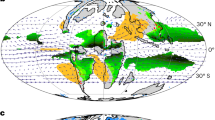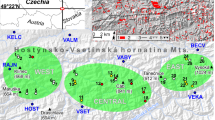Abstract
Pangaea, the largest landmass in the Earth's history, was nearly bisected by the Equator during the late Palaeozoic and early Mesozoic eras. Modelling experiments and stratigraphic studies have suggested that the supercontinent generated a monsoonal atmospheric circulation that led to extreme seasonality1,2,3, but direct evidence for annual rainfall periodicity has been lacking4. In the Mesozoic era, about 190 million years ago, thick deposits of wind-blown sand accumulated in dunes of a vast, low-latitude desert at Pangaea's western margin5,6,7. These deposits are now situated in the southwestern USA. Here we analyse slump masses in the annual depositional cycles within these deposits, which have been described for some outcrops of the Navajo Sandstone8. Twenty-four slumps, which were generated by heavy rainfall, appear within one interval representing 36 years of dune migration. We interpret the positions of 20 of these masses to indicate slumping during summer monsoon rains, with the other four having been the result of winter storms. The slumped lee faces of these Jurassic dunes therefore represent a prehistoric record of yearly rain events.
This is a preview of subscription content, access via your institution
Access options
Subscribe to this journal
Receive 51 print issues and online access
$199.00 per year
only $3.90 per issue
Buy this article
- Purchase on Springer Link
- Instant access to full article PDF
Prices may be subject to local taxes which are calculated during checkout





Similar content being viewed by others
References
Parrish, J. T., Ziegler, A. M. & Scotese, C. R. Rainfall patterns and the distribution of coals and evaporites in the Mesozoic and Cenozoic. Palaeogeogr. Palaeoclimatol. Palaeoecol. 40, 67–101 (1982).
Kutzbach, J. E. & Gallimore, R. G. Pangaean climates: megamonsoons of the megacontinent. J. Geophys. Res. 94, 3341–3357 (1989).
Chandler, M., Rind, D. & Ruedy, R. Pangaean climate during the Early Jurassic: GCM simulations and the sedimentary record of paleoclimate. Bull. Geol. Soc. Am. 104, 543–559 (1992).
Kvale, E. P. et al. Evidence of seasonal precipitation in Pennsylvanian sediments of the Illinois basin. Geology 22, 331–334 (1994).
Kocurek, G. & Dott, R. H. Jr in Mesozoic Paleogeography of West-Central United States (eds Reynolds M. W. & Dolly, E. D.) 101–116 (Rocky Mountain Section, Society of Economic Paleontologists and Mineralogists, Denver, 1983).
Blakey, R. C., Peterson, F. & Kocurek, G. Synthesis of late Paleozoic and Mesozoic eolian deposits of the western interior of the United States. Sedim. Geol. 56, 3–125 (1988).
Parrish, J. T. & Peterson, F. Wind directions predicted from global circulation models and wind directions determined from eolian sandstones of the western United States. Sedim. Geol. 56, 261–282 (1988).
Hunter, R. E. & Rubin, D. M. in Eolian Sediments and Processes (eds Brookfield, M. E. & Ahlbrandt, T. S.) 429–454 (Elsevier, Amsterdam, 1983).
Chan, M. A. & Archer, A. W. Spectral analysis of eolian foreset periodicities: implications for Jurassic decadal-scale paleoclimatic oscillators. Paleoclimates 3, 239–255 (1999).
Loope, D. B. & Rowe, C. M. Jurassic desert storms: reactivation surfaces and wind ripple wedges that punctuate grainflow tongues within the Navajo Sandstone and record the passage of cyclonic depressions. Geol. Soc. Am. Abstr. Progm 32, A308 (2000).
Cooke, R., Warren, A. & Goudie, A. Desert Geomorphology Fig. 23.22, 338 (UCL Press, London, 1993).
Bigarella, J. J., Becker, R. D. & Duarte, G. M. Coastal dune structures from Paran, Brazil. Mar. Geol. 7, 5–55 (1969).
Hunter, R. E., Richmond, B. M. & Alpha, T. R. Storm-controlled oblique dunes of the Oregon Coast. Bull. Geol. Soc. Am. 94, 1450–1465 (1983).
Hunter, R. E. Basic types of stratification in small eolian dunes. Sedimentology 24, 361–387 (1977).
Acknowledgements
This work was supported by the Schultz Chair of Stratigraphy at the University of Nebraska.
Author information
Authors and Affiliations
Corresponding author
Rights and permissions
About this article
Cite this article
Loope, D., Rowe, C. & Joeckel, R. Annual monsoon rains recorded by Jurassic dunes. Nature 412, 64–66 (2001). https://doi.org/10.1038/35083554
Received:
Accepted:
Issue Date:
DOI: https://doi.org/10.1038/35083554
This article is cited by
-
Early Paleogene precipitation patterns over East Asia: Was there a monsoon after all?
Palaeobiodiversity and Palaeoenvironments (2024)
-
From desert to monsoon: irreversible climatic transition at ~ 36 Ma in southeastern Tibetan Plateau
Progress in Earth and Planetary Science (2022)
-
A Jurassic record encodes an analogous Dansgaard–Oeschger climate periodicity
Scientific Reports (2022)
-
Markers and Genetic Mechanisms of Primary and Epigenetic Oxidation of an Aeolian Depositional System of the Luohandong Formation, Ordos Basin
Journal of Earth Science (2022)
-
Substantial vegetation response to Early Jurassic global warming with impacts on oceanic anoxia
Nature Geoscience (2019)
Comments
By submitting a comment you agree to abide by our Terms and Community Guidelines. If you find something abusive or that does not comply with our terms or guidelines please flag it as inappropriate.






